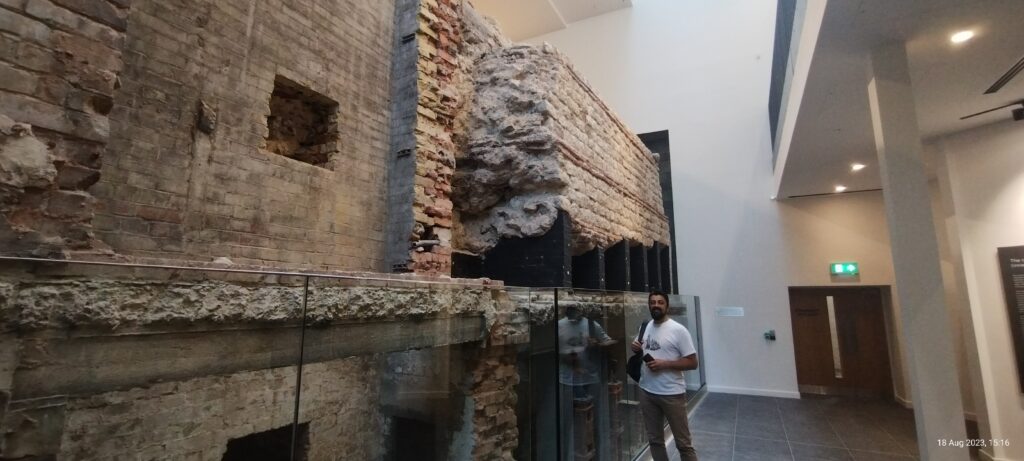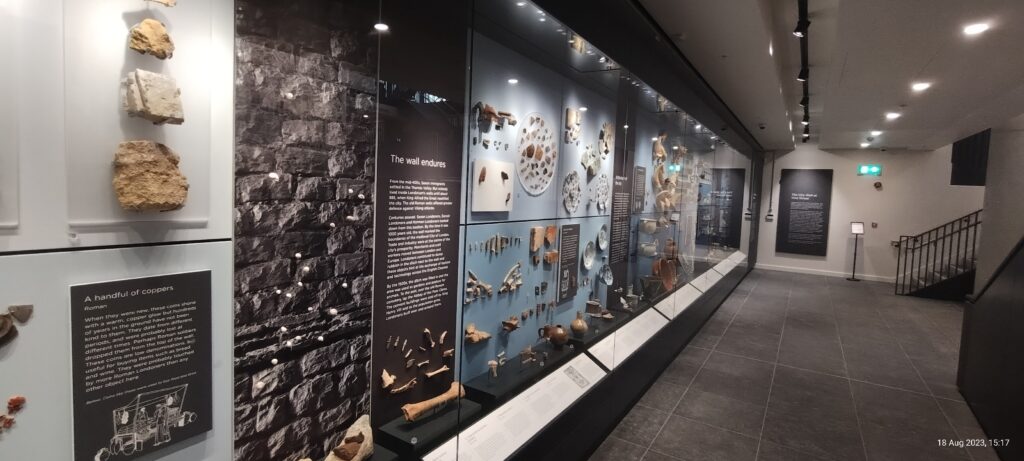An afternoon exploring Roman London
Written by Ciprian Dobra, George Peckham, and Amelia Kedge
Last Friday was a sunny afternoon in London and George and Amelia accompanied 2023 senior fellow, Ciprian Dobra, in visiting the Vine Street City Wall Museum and the London Mithraeum. Read our thoughts about our visit…
Ciprian
My last week as senior fellow made it possible for me the visit to some Roman sites in London, namely the remaining bits of the Roman wall that used to circle the city of Londinium 19 centuries ago: the London Mithraeum and the Vine Street City Wall Museum. These sites can be visited in one afternoon if someone wants to embark on the quest of finding them. I wanted to identify every location and put together a route for future ITP fellows to follow, so, using all the data provided by George, I managed to sketch an itinerary and plan my route.
One of the stops was the Vine Street Roman Wall Museum which is the fourth part of the wall as the tour begins from the Tower Hill Postern gate. I did not want to visit it all by myself, and as George and Amelia have not seen it before, we decided to share the experience.

This small museum is a site museum, with part of the roman wall being exhibited there. Its size and the content made me feel right at home because I work in a similar museum, the Principia Museum, also a Roman site but a different type of building, and probably of similar size. The Roman wall on Vine Street discovered a multitude of objects that documented the evolution of the city at that specific location, from Roman times to the moment of excavation. Luckily for us visitors, most of these objects are on display now inside this cozy space.

There is a screen next to the wall which projects a short film explaining the chronology of the site and the conclusions that resulted from the excavation. This is also similar to my museum, where a film presents to visitors the details of the excavation of the site and its evolution within the context of the city. But the similarities stop here.
This space is under the authority of the Museum of London, mine is under the authority of the City Council. Vine Street Museum has a permanent exhibition, we do not, because the area was swept by the Austrian army when the Alba Carolina Citadel was built, and besides stones and bricks only 3 coins were discovered. Vine Street is a museum and while the Principia is also a museum, it is also a public event space so there is no room for a permanent display. Vine Street has a cafeteria and we do not. But although small, I found things to learn from in order to be able to improve the museum space I work in, and I am grateful for that.

George
I had a great time on Friday afternoon exploring some of the sites which reveal glimpses of life in Roman London. I had never visited The City Wall at Vine Street and it is not the easiest museum to find! It’s tucked away on a quiet street amongst the tall buildings of the City of London. But once you find the entrance, you’ll discover inside a very modern space with the remains of a section of the original London city wall.
The site of the wall has gone through many changes before eventually becoming a museum. A 19th century warehouse covered the wall for many years, protecting it from bombing during the Second World War. In 1979 the warehouse was demolished to make room for office blocks. This was when the full extent of the remaining wall was discovered, and an archaeological excavation took place. However, it would not be until 2023 that the wall would be made accessible to the public when a new building was constructed with an exhibition space. Historic England and the Museum of London have collaborated with the City of London to make this space possible.



I was really impressed by how much the museum does with a relatively small space. The Roman wall is sleekly incorporated into the contemporary space; glass panels against the back of the wall cleverly display the modern engineering that supports the wall and helps keep it standing. Accompanying the wall is a display of archaeological finds uncovered in Vine Street and the surrounding area from the museum of London collection. The objects tell the story not just of life in Roman London, but display a chronology of 2000 years of life in the city. My favourite piece on display was a fragment of a Roman tile which bears the paw-print of a cat!


I’d highly recommend a visit to this new museum. Entry is free but just remember to book your visit in advance!
Amelia
After visiting the Vine Street museum, we visited the London Mithraeum which was only a short walk away, right next to Bank station. Built by a Roman Londoner in the 3rd century AD, the Mithraeum is a temple built to worship the God Mithras.
The cult of Mithras was an early rival to Christianity, and predominantly attracted merchants, soldiers, and imperial administrators, but excluded women. Mithraeums were typically private, dark, windowless spaces, depicting mythological scenes of Mithras, such as his birth from a rock, and slaughtering a bull; a ‘tauroctony’.
The site of the London Mithraeum experienced heavy bombing in 1941 during the Blitz but wasn’t excavated until September 1954. It wasn’t until the final day of the dig that the site was confirmed as a Mithraeum, when a marble head of Mithras was discovered. Today, the temple has been restored and is displayed underground, at what would’ve been street level in 240 AD. An immersive experience with lights, haze and the sounds of footsteps, chanting and whispers bring the space alive, and makes you feel like you’re spying on a secret ritual.


As well as the underground Mithraeum, archaeological finds from the dig are also on display here, featuring examples of Roman pottery, mosaic, coins, and jewellery. My favourite object was a leather shoe, miraculously preserved over the centuries in the mud surrounding the Mithraeum, perhaps once belonging to someone who worshipped there. This display also had an element of interactivity, as visitors were encouraged to use the iPads provided which gave more information about the objects in easy to read snippets.

As well as the objects and the interactivity, one of the standout features of the Mithraeum is that it is free to visit! And just round the corner from the Roman wall, makes for an interesting afternoon exploring London’s Roman history.
